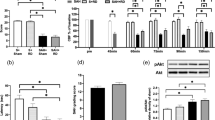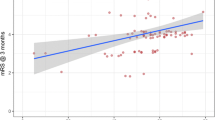Abstract
Background and Purpose
No experimental data has been published on the long-term effects of decompressive craniotomy in hypertensive rats with space-occupying cerebral infarction. The aim of the present study was to investigate the efficacy of decompressive craniectomy in a middle cerebral artery occlusion (MCAO) model of hypertensive rats in a prolonged period.
Methods
Totally 92 stroke-prone renovascular hypertensive rats (RHRSP) were subjected to left MCAO by an endovascular occlusion technique. The decompressive craniectomy was performed on 26 RHRSP at 1 and 24 h after MCAO, respectively. Infarct volume, neurological performance, and mortality were evaluated at 1, 2, 4, and 8 weeks after MCAO.
Results
The mortality was reduced from 52.5% in controls to 7.7% and 23.1% in the rats underwent craniectomy at 1 and 24 h after MCAO, respectively (P < 0.05, respectively). All of the treated rats presented smaller infarct volume from 1 week to 8 weeks and better neurological performance at 4–8 weeks after MCAO compared to the controls (P < 0.05, respectively). The craniectomy at early stage was more effective than that at late stage in reducing infarct volume and improving neurological performances at 1 and 2 weeks (P < 0.05, respectively). However, there was no significant difference in infarct volume and neurological scores between the treated groups of rats at 4 and 8 weeks after MCAO (P > 0.05).
Conclusions
Although the early craniectomy is more effective than delayed craniectomy in improving short-term outcome, the latter has the similar beneficial effects as early craniectomy on long-term outcome in hypertensive rats with space-occupying cerebral infarction.


Similar content being viewed by others
References
Hacke W, Schwab S, Horn M, Spranger M, De Georgia M, von Kummer R. “Malignant” middle cerebral artery territory infarction: clinical course and prognostic signs. Arch Neurol 1996;53(2):309–15.
Rieke K, Schwab S, Krieger D, et al. Decompressive surgery in space-occupying hemispheric infarction: results of an open, prospective trial. Crit Care Med 1995;23(9):1576–87.
Schwab S, Steiner T, Aschoff A, et al. Early hemicraniectomy in patients with complete middle cerebral artery infarction. Stroke 1998;29(9):1888–93.
Georgiadis D, Schwarz S, Aschoff A, Schwab S. Hemicraniectomy and moderate hypothermia in patients with severe ischemic stroke. Stroke 2002;33(6):1584–88.
Vahedi K, Hofmeijer J, Juettler E, et al. DECIMAL, DESTINY, and HAMLET investigators. Early decompressive surgery in malignant infarction of the middle cerebral artery: a pooled analysis of three randomised controlled trials. Lancet Neurol 2007;6(3):215–22.
Donnan GA, Davis SM. Surgical decompression for malignant middle cerebral artery infarction: a challenge to conventional thinking. Stroke 2003;34(9):2307.
Schwab S, Hacke W. Surgical decompression of patients with large middle cerebral artery infarcts is effective. Stroke 2003;34(9):2304–5.
Brown MM. Surgical decompression of patients with large middle cerebral artery infarcts is effective: not proven. Stroke 2003;34(9):2305–6.
Forsting M, Reith W, Schabitz WR, et al. Decompressive craniectomy for cerebral infarction: an experimental study in rats. Stroke 1995;26(2):259–64.
Doerfler A, Forsting M, Reith W, et al. Decompressive craniectomy in a rat model of “malignant” cerebral hemispheric stroke: experimental support for an aggressive therapeutic approach. J Neurosurg 1996;85(5):853–9.
Doerfler A, Schwab S, Hoffmann TT, Engelhorn T, Forsting M. Combination of decompressive craniectomy and mild hypothermia ameliorates infarction volume after permanent focal ischemia in rats. Stroke 2001;32(20):2675–81.
Engelhorn T, Doerfler A, Kastru A, et al. Decompressive craniectomy, reperfusion, or a combination for early treatment of acute “malignant” cerebral hemispheric stroke in rats? Potential mechanisms studied by MRI. Stroke 1999;30(7):1456–63.
Matsushita K, Kuriyama Y, Nagatsuka K, Nakamura M, Sawada T, Omae T. Periventricular white matter lucency and cerebral blood flow autoregulation in hypertensive patients. Hypertension 1994;23(5):565–8.
Nag S, Kilty DW. Cerebrovascular changes in chronic hypertension: protective effects of enalapril in rats. Stroke 1997;28(5):1028–34.
Duverger D, MacKenzie ET. The quantification of cerebral infarction following focal ischemia in the rat: influence of strain, arterial pressure, blood glucose concentration, and age. J Cereb Blood Flow Metab 1988;8(4):449–61.
Zeng J, Zhang Y, Mo J, Su Z, Huang R. Two-kidney two-clip renovascular hypertensive rats can be used as stroke-prone rats. Stroke 1998;29(8):1708–14.
Koizumi J, Yoshida Y, Nakazawa T, Ooneda G. Experimental studies of ischemic brain edema I: a new experimental model of cerebral embolism in rats in which recirculation can be introduced in the ischemic area. Jpn J Stroke 1986;8(1):1–8.
Menzies SA, Hoff JT, Betz LA. Middle cerebral artery occlusion in rats: a neurological and pathological evaluation of a reproducible model. Neurosurgery 1992;31(1):100–7.
Lin TN, He YY, Wu G, Khan M, Hsu CY. Effect of brain edema on infarct volume in a focal cerebral ischemia model in rats. Stroke 1993;24(1):117–21.
Zeng J, Huang R, Su Z. Stroke-prone renovascular hypertensive rats. Chin Med J (Engl) 1998;111(8):741–4.
Hofmeijer J, Schepers J, Veldhuis WB, et al. Delayed decompressive surgery Increases apparent diffusion coefficient and improves peri-infarct perfusion in rats with space-occupying cerebral infarction. Stroke 2004;35(6):1476–81.
Cho DY, Chen TC, Lee HC. Ultra-early decompressive craniectomy for malignant middle cerebral artery infarction. Surg Neurol 2003;60(3):227–32.
Engelhorn T, von Kummer R, Reith W, Forsting M, Doerfler A. What is effective in malignant middle cerebral artery infarction: reperfusion, craniectomy, or both? An experimental study in rats. Stroke 2002;33(2):617–22.
Acknowledgments
This study was supported by the grants from the Teaching and Research Award Program for Outstanding Young Teachers in Higher Education Institutions of the Ministry of Education, China (2002), the National Natural Science Foundation of China (Nos. 39940012, and 30271485), the Natural Science Foundation of Guangdong Province, China (Nos. 990065, 21906, and 2003C30610), China Medical Board of New York Inc. (No. CMB00-730), the Fund for Priority Subjects in Clinical Medicine, Chinese Ministry of Health (2004), the Key and Scientific Project of the Natural Science Foundation of Guangdong Province, China (Nos. 2003B30303, 2003C30610 and 2003D30301) and the fund on collaboration study for First Affiliated Hospital and Life Science Institute in Sun Yat-Sen University (2006).
The funding sources were not involved in study design; collection, analysis, and interpretation of data; writing of the report; decision to submit the paper for publication.
Author information
Authors and Affiliations
Corresponding author
Additional information
Zhan Zhao and Jian Yu have contributed equally to this work.
Rights and permissions
About this article
Cite this article
Zhao, Z., Yu, J., Liao, S. et al. Delayed Decompressive Craniectomy Improves the Long-term Outcomes in Hypertensive Rats with Space-occupying Cerebral Infarction. Neurocrit Care 7, 263–269 (2007). https://doi.org/10.1007/s12028-007-0074-0
Published:
Issue Date:
DOI: https://doi.org/10.1007/s12028-007-0074-0




